
Sergei Iosifovich Parajanov(January 9, 1924 – July 20, 1990) was a Soviet film director and screenwriter. He is regarded by film critics, film historians and filmmakers to be one of the greatest filmmakers of all time.
Mikhail Vartanov was a Soviet filmmaker and cinematographer who made significant contribution to world cinema with the documentary films Parajanov: The Last Spring and Seasons.

The culture of Armenia encompasses many elements that are based on the geography, literature, architecture, dance, and music of the Armenian people. Armenia is a majority Christian country in the Caucasus.
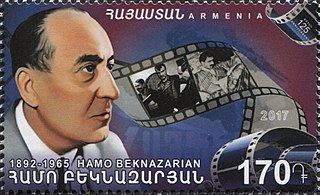
Hamo Beknazarian, also known as Hamo Bek-Nazarov or Amo Bek-Nazarian, was an Armenian film director, actor and screenwriter.

The Golden ApricotYerevan International Film Festival is an annual film festival held in Yerevan, Armenia. The festival was founded in 2004 with the co-operation of the "Golden Apricot" Fund for Cinema Development, the Armenian Association of Film Critics and Cinema Journalists. The GAIFF is continually supported by the Ministry of Foreign Affairs of Armenia, the Ministry of Culture of Armenia and the Benevolent Fund for Cultural Development.The objectives of the festival are "to present new works by the film directors and producers in Armenia and foreign cinematographers of Armenian descent and to promote creativity and originality in the area of cinema and video art".
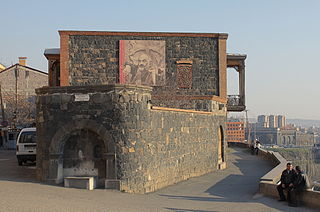
The Sergei Parajanov Museum is a tribute to Soviet Armenian film director and artist Sergei Parajanov and is one of the most popular museums in Yerevan. It represents Parajanov's diverse artistic and literary heritage.

Armenfilm, also known as Hayfilm, is an Armenian film studio company located in Yerevan. The studio company was founded on 16 April 1923 as a production unit of the Soviet State Cinema Organization, with Daniel Dznuni as the first director.

Harutyun Khachatryan is an Armenian film director, script writer, director of photography, film producer, General director of the Golden Apricot Yerevan International Film Festival, Meritorious Artist of the Republic of Armenia and voting Member of European Film Academy since 2006.
Rudolf Vatinyan was an Armenian cinematographer.

Namus is a 1925 silent drama film by Hamo Beknazarian, based on Alexander Shirvanzade's 1885 novel of the same name, which denounces the despotic rites and customs of Caucasian families. It is widely recognized as the first Armenian feature film.
Arman Manaryan was an Iranian-born Armenian film director. He was the brother of actor Yervand Manaryan. He repatriated to Soviet Armenia in 1946 and graduated from the Yerevan State Conservatory in 1952 and from the Moscow Institute of Cinematography in 1962. Since then he worked with Armenfilm. He died in 2016, aged 86.
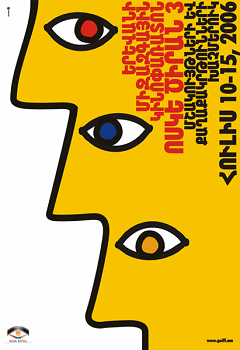
The 3rd Yerevan Golden Apricot International Film Festival was a film festival held in Yerevan, Armenia from 10–15 July 2006. The annual festival presented about 120 films from 43 countries. Participants included some of the most highly acclaimed figures of world cinema - such as Marco Bellocchio, Tonino Guerra, Mohsen Makhmalbaf, Godfrey Reggio and Artavazd Peleshyan, who were honored with Lifetime Achievement Awards. More than 110 foreign guests attended the festival, which included filmmakers, actors, producers and distributors. The festival was covered by a number of international media, including Euronews and Arte. The international juries, headed by Moritz de Hadeln, Godfrey Reggio and Arsinee Khanjian, awarded the following prizes: Golden Apricot 2006 for the Best Feature Film to Hou Hsiao-hsien for his film Three Times, (Taiwan/China/France); Golden Apricot 2006 for the Best Documentary Film to Workingman's Death by Michael Glawogger, (Austria); and Golden Apricot 2006 for the Best Film in "Armenian Panorama" to The Dwellers of Forgotten Islands by Hrant Hakobyan, (Armenia).

The 4th Yerevan Golden Apricot International Film Festival was a film festival held in Yerevan, Armenia from 9–14 July 2007. More than 120 films from around the world were presented during the festival with attendance from contemporary filmmakers such as Bruno Dumont, Leos Carax, Carla Garapedian, Lee Chang-dong, Andrey Zvyagintsev, Aurora Quattrocchi and Tchéky Karyo. Paolo and Vittorio Taviani (Italy), directors of The Lark Farm were honored with Lifetime Achievement Awards. The international juries, headed by An Cheong-sook, Martin Schweighofer (Austria), Vigen Chaldranyan (Armenia) awarded the following prizes: Golden Apricot 2007 for the Best Feature Film to Ulrich Seidl for his film Import/Export (Austria); Golden Apricot 2007 for the Best Documentary Film to Vardan Hovhannisyan for his film A Story of People in War and Peace (Armenia) and Golden Apricot 2007 for the Best Film in the “Armenian Panorama” to Screamers by Carla Garapedian (UK). Vardan Hovhannisyan was awarded with the FIPRESCI and Ecumenical Jury Prizes and Carla Garapedian (Screamers) was also awarded the Ecumenical Jury Price.

The 5th Yerevan Golden Apricot International Film Festival was a film festival held in Yerevan, Armenia from 13–20 July 2008. The festival had more than 450 submissions from 67 countries; viewers had an opportunity to see over 160 films. Among the honorable guests of the festival were Wim Wenders, Enrica Antonioni, Goran Paskaljevic, Dariush Mehrjui, Catherine Breillat, and others. A Special Tribute was paid to Michelangelo Antonioni by honoring him with a posthumous Parajanov’s Thaler. Additionally, Wim Wenders and Dariush Mehrjui were honored with Parajanov’s Thaler Lifetime Achievement Awards. The main prizewinners of the 5th Golden Apricot were Anna Melikian from Russia for her film The Mermaid, Meira Asher from Israel for the film Women See Lot of Things, and Eric Nazarian from the USA for The Blue Hour. The FIPRESCI Award went to Huseyn Karabey with his film My Marlon and Brando and the Ecumenical Award to Eric Nazarian with his film The Blue Hour.
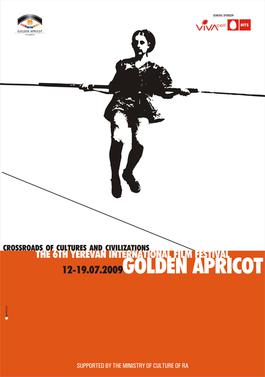
The 6th Yerevan Golden Apricot International Film Festival was a film festival held in Yerevan, Armenia from 12–19 July 2009. The annual festival had over 450 submissions from 67 countries, 150 of which were included into the competition and non-competition programs. Over 250 accredited press representatives covered the festival. This was the fourth year the festival was widely covered by Euronews. Among honorable guests were filmmakers Rob Nilsson, Kohei Oguri (Japan), Alexander Rodnyansky (Russia), Sergei Solovyov (Russia), actors Eric Bogosian, Arsinee Khanjian (Canada) and producer Alain Terzian. The international juries, headed by Kohei Oguri, Alexander Rodnyansky, Haig Balian (Netherlands) awarded the following prizes: Golden Apricot 2009 for the Best Feature Film to George Ovashvili for his film The Other Bank (Georgia); Golden Apricot 2009 for the Best Documentary Film to Anders Østergaard for his film Burma VJ - Reporting from a Closed Country (Denmark), and Golden Apricot 2009 for the Best Film in the “Armenian Panorama” to With Love and Gratitude by Arka Manukyan (Armenia). The FIPRESCI Award went to Ozcan Alper’s Autumn and the Ecumenical Award to George Ovashvili’s The Other Bank.
Ashot Karlosi Adamyan is an Armenian film and stage actor.
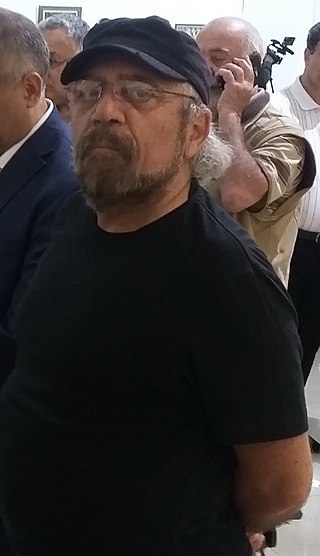
Ruben Kochar Armenian: Ռուբեն Երվանդի Քոչար is an Armenian film director, writer, producer and painter. He is an Honored Artist of Armenia.
Apricot Groves is a 2016 Armenian–Iranian drama film directed by Pouria Heidary Oureh. The film is one of the most internationally appeared film in the history of Armenian cinema, with dozens of international film festival selections.

Aurora's Sunrise is a 2022 adult animated documentary film directed by Inna Sahakyan. It is based on the life of Aurora Mardiganian, an Armenian Genocide survivor who after her escape became an actress in the United States. The film includes short scenes of the film Auction of Souls, a silent film from 1919 on the Armenian Genocide, in which Aurora Mardiganian had the leading role.
















